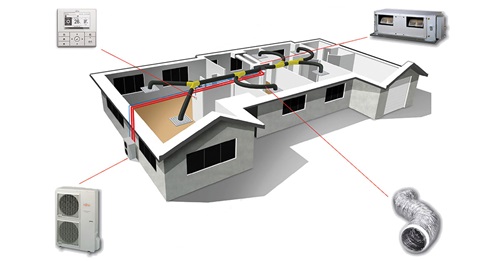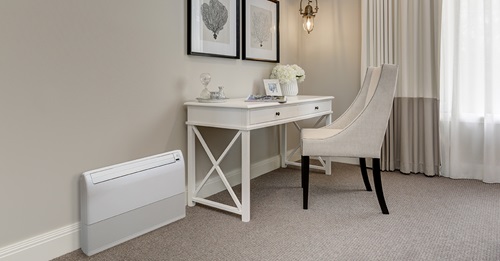How to Zone Ducted Air Conditioning Effectively

Air conditioners run best when the system is designed and installed correctly, ensuring the right balance of airflow throughout the home. Ducted air conditioning is a complete solution that ensures the entire home, or specific rooms with zone control, will be comfortable at any time of day or night.
Ducted air conditioning allows for the home to be divided into separate areas, or ‘zones’. Zoning will allow you to have greater control over the airflow around the home and provides flexibility to use your system to suit your living arrangements and lifestyle. Depending on the air conditioning system, you can select which zones are on or off, or with advanced controllers select different temperatures for specific zones at the same time. This can improve energy efficiency and deliver superior comfort.
Related Article: How To Run Your Air Conditioner Efficiently
What is a zoning and how does it work?
All Fujitsu Ducted air conditioners can be set up with zones whilst using optional zone control., A zoned air conditioning system allows for individual control over different areas within your home. By dividing the space into distinct climate control zones, these home air conditioners can provide comfort tailored to its occupants and reduce household energy bills.
Fujitsu General’s ducted air conditioners are able to split your home into cooling zones. Our anywAiR technology ducted controller gives you complete control of your ducted air conditioning zones via a wall mounted touchpad or remotely using the anywAiR app. Create programmable scenarios and commands to change the mode or open and close zones within your home.
With their advanced technology, Fujitsu General ducted air conditioning systems are able to deliver personalised comfort and reduced energy consumption.
Consider the following factors to help determine the best way to divide your house into zones.
Evaluate the home design
The home design is the most crucial element to examine when determining zones. Look for parts of the home that might have significantly higher or lower loads than other parts. Hot air rises, so if you have a multi-story home, separate zones should be used for separate floors. Rooms with lots of windows or large doorways will also likely need separate zones.
Determine natural heating and cooling
It is important to factor in the outdoor temperature or sunlight that penetrates a room or zone through windows or skylights. Basements and subterranean rooms are insulated and tend to be much cooler, whereas attics are much hotter. Ensure that sun-facing rooms and shaded ones are separated into different zones, since rooms that face the sun absorb more heat.
Consider room use
Rooms that are used for different functions or at different times of the day should be zoned separately. Bedrooms and living areas should be separate zones, as bedrooms are used mostly in the morning and night, whereas living areas are used during the day and evening. Typically, most homes will have separate zones for the master suite, other regularly used bedrooms, and the living areas.
Multiple rooms in a zone
It is common for a zone to contain more than one room, for example a living area may include a kitchen and dining area. However, only do so if there is open connection or doorways between the rooms. The more open the rooms are to other rooms within a zone, the more resilient the zone will be to imbalances in heating and cooling loads.
Create a constant zone
The constant zone is an area that is always supplied with air while the system is running. Having a constant zone provides somewhere consistent for the air conditioner to operate and ensure all zones are not closed at once, allowing your installer to correctly balance the unit. The main living area is commonly used as the constant zone as it is occupied the most throughout the day.
Fujitsu General’s range of ducted air conditioners are designed using the latest technology to offer seamless comfort to you and your family. These systems are able to vary the flow of air to each zone, ensuring the desired temperature is maintained. By considering the layout and building characteristics in your home, you are able to create zones that function effectively and reduce household energy consumption. For more information on how to zoneducted air conditioners, contact Fujitsu’s helpful team.
How Do Ducted Air Conditioners Work: Frequently Asked Questions
Is adding zones to existing ducted air conditioning possible?
It is possible heating and cooling zones to existing ducted air conditioning systems. The ducting in your system must be extended to each unique area. Adding zones can be a costly exercise, depending on the ducting already in place and the amount of space available. Contact a Fujitsu technician if you believe your ducted air conditioner requires additional zones.
What are the benefits of multiple zones set up on a ducted air conditioning?
A zoned ducted air conditioner’s primary advantage is the increased comfort level it provides. Heating or cooling zones allow your household to choose their comfort preferences and adjust the airflow or temperature in their space accordingly. While you can control the individual temperature in each room, the ducted system must be set to the same mode for the whole house (e.g. heating or cooling)
With the anywAiR technology ducted controller, the user can select the percentage of airflow for each zone from 0 to 100 percent, in 5 percent increments. This gives you greater control of airflow to each zone to better meet your comfort needs.
When temperature sensors are installed the user can choose the desired temperature for a zone and the system will automatically adjust the airflow to assist in maintaining each zone’s desired temperature.
Zoned air conditioning also helps you save energy by only cooling or heating the rooms that are currently being used. Being able to switch off the air conditioning in certain areas of your home is an advantage if you have a large home, or rooms that are not used very often.
Contact Fujitsu General to learn more about ducted air conditioning, or adding zones to the system in your home.


.tmb-tmb420.jpg?sfvrsn=5c4be2e1_1)


